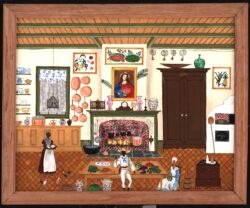Creole New Orleans, Honey! The Art of Andrew LaMar Hopkins
A self-taught artist explores Louisiana’s Creole past
Published: May 31, 2023
Last Updated: August 31, 2023

Loan from Rick Ellis, image courtesy Louisiana State Museum
Andrew LaMar Hopkins, Creole Kitchen, 2013. Acrylic on canvas.
His work—which has recently attracted attention from the New York Times, Wall Street Journal, and The Magazine Antiques, among others—is the subject of a new Louisiana State Museum exhibition at the Cabildo. The first solo museum exhibition of the artist’s work, it features more than seventy of Hopkins’s unique paintings alongside artifacts from the museum that inspired some of them.
Hopkins’s paintings generally depict the upper crust of Creole society and celebrate the elegance and beauty of the world they created. Though his subjects include white Creoles, his focus is on mixed-race and Black Creoles in the 1820s and 1830s. “You know, I paint everybody from that period,” Hopkins told New York Magazine. “But my main focus is the free people of color because their voice has been forgotten.”
The artist’s passion for history and decorative arts inspired him to volunteer at the Louisiana State Museum during his early adulthood. Works in the museum’s collection, including paintings by José Francisco Xavier de Salazar y Mendoza and rare Louisiana decorative arts and furniture, directly shaped Hopkins’s painting style and subject matter. Some of these artifacts, among the most important items in the museum’s collection, are included in the exhibition.
The exhibit is organized around five themes. One focuses on the complex nature of Creole identity and changing definitions of the word “Creole,” while another focuses on Hopkins’s representation of Creoles. A third thematic area explores Hopkins’s lavish interiors, while a fourth considers his depiction of Creole architecture. The final section investigates the way Hopkins’s work challenges conventional conceptions of gender and sexuality, particularly through the inclusion of his alter ego, Désirée Josephine Duplantier, in some of his paintings.
Creole New Orleans, Honey! The Art of Andrew LaMar Hopkins will be on display at the Cabildo through September 30, 2023. It is accompanied by an exhibition catalog of the same name available for purchase through the 1850 House Museum Store.
—Joyce Miller, Museum Historian
